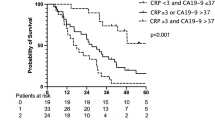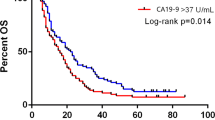Abstract
CA19-9 serum has been suggested as a marker of unresectability but different cut-off levels have been published. A cut-off of 500 U/ml is currently considered in an international consensus as biological criteria of borderline resectable pancreatic adenocarcinoma. To evaluate whether serum CA19-9 threshold of 500 U/ml could be adequate predictor of resectability in pancreatic adenocarcinoma. Multicenter, observational, prospective study performed in Spain including 203 patients diagnosed with pancreatic adenocarcinoma. 43 (21.2%) cases were resectable and 160 (78.8%) unresectable. Among the 176 preoperative CA19-9 available values, 98 (58.3%) were ≤ 500 U/ml and 73 (42.7%) > 500 U/ml. Resectability rate in those patients with CA19-9 ≤ 500 U/ml was 60% while it was found to be 18% when CA19-9 > 500 U/ml. Statistical model to predict resectability based on CA19-9 provide an AUC of 0.6618 (95% CI 0.53–0.83) when only CA19-9 values > 500 U/ml are studied. Serum levels of CA19-9 higher than 500 U/ml are indicative of unresectable disease, however reduced sensitivity and specificity lead to a limited clinical applicability for resectability.



Similar content being viewed by others
References
Xu Y-P (2016) Advancement in treatment and diagnosis of pancreatic cancer with radiopharmaceuticals. World J Gastrointest Oncol 8(2):165
Bray F, Ferlay J, Soerjomataram I, Siegel RL, Torre LA, Jemal A (2018) Global cancer statistics 2018: GLOBOCAN estimates of incidence and mortality worldwide for 36 cancers in 185 countries. CA Cancer J Clin 68(6):394–424
Lamerz R (1999) Role of tumour markers cytogenetics. Ann Oncol 10:145–149
Goh SK, Gold G, Christoph C, Muralidharan V (2017) Serum carbohydrate antigen 19-9 in pancreatic adenocarcinoma: a mini review for surgeons. ANZ J Surg 87(12):987–992
Ferrone CR, Finkelstein DM, Thayer SP, Muzikansky A, Fernandezdel Castillo C, Warshaw AL et al (2006) Perioperative CA19-9 levels can predict stage and survival in patients with resectable pancreatic adenocarcinoma. J Clin Oncol 24:2897–2902
Barton JG, Bois JP, Sarr MG, Wood CM, Qin R, Thomsen KM et al (2009) Predictive and prognostic value of CA 19-9 in resected pancreatic adenocarcinoma. J Gastrointest Surg 13:2050–2058
Karachristos A, Scarmeas N, Hoffman JP (2005) CA 19-9 levels predict results of staging laparoscopy in pancreatic cancer. J Gastrointest Surg 9:1286–1292
Maithel SK, Maloney S, Winston C, Gonen M, D’Angelica MI, Dematteo RP, Jarnagin WR, Brennan MF, Allen PJ (2008) Preoperative CA 19-9 and the yield of staging laparoscopy in patients with radiographically resectable pancreatic adenocarcinoma. Ann Surg Oncol 15:3512–3520
Halloran CM, Ghaneh P, Connor S, Sutton R, Neoptolemos JP, Raraty MG (2008) Carbohydrate antigen 19.9 accurately selects patients for laparoscopic assessment to determine resectability of pancreatic malignancy. Br J Surg 95:453–459
Kilic M, Gocmen E, Tez M, Ertan T, Keskek M, Koc M (2006) Value of preoperative serum CA 19-9 levels in predicting resectability for pancreatic cancer. Can J Surg 49:241–244
Ballehaninna U, Chamberlain R (2011) Serum CA19-9 as biomarker of pancreatic cancer—a comprehensive review. Indian J Surg Oncol 2(2):88–100
Alexakis N, Gomatos IP, Sbarounis S et al (2015) High serum CA 19-9 but not tumor size should select patients for staging laparoscopy in radiological resectable pancreas head and peri-ampullary cancer. Eur J Surg Oncol 41:265–269
Mirkin KA, Hollenbeak C, Wong J. (2017) Prognostic impact of carbohydrate antigen 19-9 level at diagnosis in resected stage I-III pancreatic adenocarcinoma: a U.S. population study. J Gastrointest Oncol 8(5):778–788.
Santucci N, Facy O, Ortega-Deballon P, Lequeu JB, Rat P, Rat P (2018) CA19-9 predicts resectability of pancreatic cancer even in jaundiced patients. Pancreatology 18(6):666–670
Hartwig W, Strobel O, Hinz U, Fritz S, Hackert T, Roth C et al (2013) CA19-9 in potentially resectable pancreatic cancer: perspective to adjust surgical and perioperative therapy. Ann Surg Oncol 20(7):2188–2196
Isaji S, Mizuno S, Windsor J, Bassi C, Fernandez-del Castillo C, Hackert et al (2018) International consensus on definition and criteria of borderline resectable pancreatic ductal adenocarcinoma 2017. Pancreatology 18:2–11
Harris PA, Taylor R, Thielke R, Payne J, Gonzalez N, Conde JG (2009) Research electronic data capture (REDCap)—a metadata-driven methodology and workflow process for providing translational research informatics support. J Biomed Inform 42(2):377–381
Gress FG, Hawes RH, Savides TJ et al (1999) Role of EUS in the preoperative staging of pancreatic cancer: a large single-center experience. Gastrointest Endosc 50:786–791
Rahib L, Smith BD, Aizenberg R et al (2014) Projecting cancer incidence and deaths to 2030: the unexpected burden of thyroid, liver, and pancreas cancers in the United States. Cancer Res 74:2913–2921
Aggarwal G, Kamada P, Chari ST (2013) Prevalence of diabetes mellitus in pancreatic cancer compared to common cancers. Pancreas 42:198–201
Soriguer F, Goday A, Bosch-Comas A et al (2012) Prevalence of diabetes mellitus and impaired glucose regulation in Spain: the diabetes study. Diabetologia 55:88. https://doi.org/10.1007/s00125-011-2336-9
Zhang S, Wang Y-M, Sun C-D, Lu Y, Wu L-Q (2008) Clinical value of serum CA19-9 levels in evaluating resectability of pancreatic carcinoma. World J Gastroenterol 14(23):3750–3753
Bergquist JR, Puig CA, Shubert CR, Groeschl RT, Habermann EB, Kendrick ML, Nagorney DM, Smoot RL, Farnell MB, Truty MJ (2016) Carbohydrate antigen 19-9 elevation in anatomically resectable, early stage pancreatic cancer is independently associated with decreased overall survival and an indication for neoadjuvant therapy: a national cancer database study. J Am Coll Surg 223(1):52–65
Tanaka M, Heckler M, Mihaljevic AL, Sun H, Klaiber U, Heger U, Büchler MW, Hackert T (2019) CT response of primary tumor and CA19-9 predict resectability of metastasized pancreatic cancer after FOLFIRINOX. Eur J Surg Oncol 45(8):1453–1459
Van Veldhuisen E, Vogel JA, Klompmaker S, Busch OR, van Laarhoven HWM, van Lienden KP, Wilmink JW, Marsman HA, Besselink MG (2018) Added value of CA19-9 response in predicting resectability of locally advanced pancreatic cancer following induction chemotherapy. HPB (Oxf) 20(7):605–611
Funding
This study did not receive any specific funding.
Author information
Authors and Affiliations
Contributions
RL and BL performed the study conception and design. RL, MM (Mario Montes), RM, FM, CJ, IE, GE, M-ME, MM (Mario Montes), DME, G-CM, I-GA and LB, participated in sample and clinical data adquisition. HM and MI performed statistical analysis. HM, BL and RL analyzed and interpreted the data, drafted and wrote the manuscript. All authors performed a critical revision and approved the manuscript.
Corresponding author
Ethics declarations
Conflict of interest
The authors declare that they have no conflict of interest.
Additional information
Publisher's Note
Springer Nature remains neutral with regard to jurisdictional claims in published maps and institutional affiliations.
Electronic supplementary material
Below is the link to the electronic supplementary material.
11033_2020_5245_MOESM1_ESM.jpg
Supplementary Figure 1. Box plot 1. Boxplot showing CA19-9 values in no jaundice and jaundice patients (JPG 13 kb). Supplementary material 1 (DOCX 14 kb)
11033_2020_5245_MOESM2_ESM.jpg
Supplementary Figure 2. Receiver Operating Characteristic (ROC) curve of CA 19.9 as indicator of jaundice (JPG 15 kb). Supplementary material 1 (DOCX 16 kb)
Rights and permissions
About this article
Cite this article
Herreros-Villanueva, M., Ruiz-Rebollo, L., Montes, M. et al. CA19-9 capability as predictor of pancreatic cancer resectability in a Spanish cohort. Mol Biol Rep 47, 1583–1588 (2020). https://doi.org/10.1007/s11033-020-05245-5
Received:
Accepted:
Published:
Issue Date:
DOI: https://doi.org/10.1007/s11033-020-05245-5




